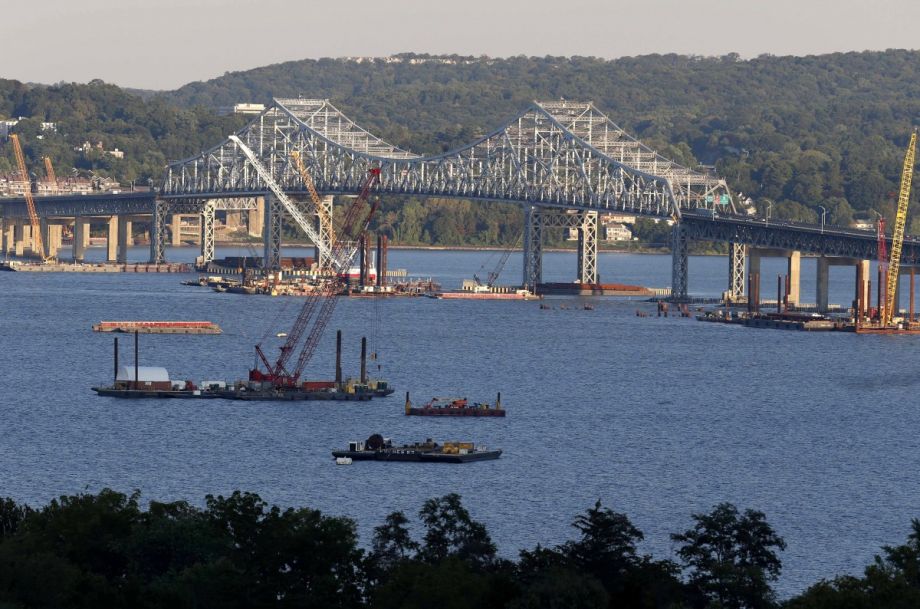Savvy travelers seeking to avoid the crawling pace of the George Washington Bridge (of Bridgegate fame), which carries I-95 over the Hudson River but snarls with city traffic in the Bronx, have long opted for the Tappan Zee Bridge farther north. After only 50 years, however, the Tappan Zee — opened in 1955 — is slated for a replacement. While allowing bikes, pedestrians and mass transit to use an interstate highway would have been unthinkable in the era of the Eisenhower interstate highway boom, the 21st-century bridge, even in the suburbs, will be multimodal.
At three miles, the Tappan Zee is the longest bridge in New York State, even though there are many other spots where the Hudson is narrower. The reason: Any farther south and it would have fallen under the jurisdiction of the Port Authority of New York and New Jersey. Instead, the New York State Thruway Authority, wholly under Albany’s control, owns and operates the span. That means the burden falls squarely on Governor Andrew Cuomo, who is up for reelection this fall.
Thus far, he can boast of an under-budget project slated to cost $4 billion by the time both spans are completed in 2018. For now, the first pilings are popping out of the Hudson alongside the existing bridge, which carries 40 percent more cars per day than initially anticipated. Of them, a whopping 98 percent are single-occupant vehicles, something that the new bridge — which does not yet have a name — hopes to alleviate.
For starters, like the George Washington Bridge to the south and the Newburgh-Beacon Bridge to the north, the new Hudson River crossing will allow pedestrians and bikes to cross. Although the three-mile distance is considerably longer than its upriver and downriver neighbors, it could still prove popular, especially with recreational cyclists.
Critics, however, have pointed out that as a $400 million chunk of the new bridge’s budget, this bike and pedestrian lane costs 45 times more than Janette Sadik-Khan’s first three years of bike-friendly investments in NYC. The possibility of converting the existing Tappan Zee into a pedestrian bridge once it is decommissioned has also raised the specter of a boondoggle.
Meanwhile, NIMBYism has reared its head in South Nyack, on the bridge’s west end, where neighbors are worried the bike and pedestrian crowd will create an attraction as popular as Poughkeepsie’s Walkway Over the Hudson, another car-free river crossing.
But the proposal that has the most potential impact on local travel patterns is the possibility of amped-up public transit service. Currently, just a few county bus lines cross the Tappan Zee, even though the new bridge’s Mass Transit Task Force (MTTF) estimated in a February 2014 report that more commuters travel within or between Rockland and Westchester counties, which the bridge connects, than from those counties to nearby New York City.
Consequently, the MTTF recommended a bus rapid transit (BRT) network that would cross the bridge, hit several commuter rail stations, and connect major job centers like Yonkers, White Plains and Port Chester. “The recommended BRT system will be a game-changer for mass transit in the region by increasing ridership by 10,150 people per day and decreasing commute times by as much as 25 percent. It offers new mobility options while also creating opportunities for sustainable, transit-oriented growth in both Rockland and Westchester along the network,” says Commissioner Joan McDonald from the New York State Department of Transportation and co-chair of the MTTF.
This idea has its skeptics as well. A Columbia University urban planning studio concluded in May that BRT was not viable. “In most cases, transit supporting densities are non-existent in the primarily low-density Hudson Valley environment,” the studio’s teacher, Floyd Lapp, emailed. “The Governor’s Task Force was too wedded to only one approach: a network of BRT routes. However, like other cases where all the chips are placed on one option, there is usually more to it than that.”
Some serious transit-oriented development (TOD) would have to take place in order for BRT to provide a meaningful alternative to driving and paying the toll, even if almost certainly cheaper. The MTTF identified a handful of sites, such as a transit center in White Plains, a closed GM plant in Tarrytown at the foot of the bridge, and a former hospital site in Port Chester, that could become TOD hubs for the eventual BRT route.
But suburban attitudes die hard. A developer has struggled to overcome yet more local NIMBY sentiment with Port Chester’s United Hospital, where residents have challenged density and apartments oriented toward millennials. While in four years it will be possible to walk, bike and likely ride a BRT over the new New York bridge, whether there will be many places worth getting to on either side depends on these Lower Hudson Valley counties accepting a new landscape.
The Works is made possible with the support of the Surdna Foundation.

Gregory Scruggs is a Seattle-based independent journalist who writes about solutions for cities. He has covered major international forums on urbanization, climate change, and sustainable development where he has interviewed dozens of mayors and high-ranking officials in order to tell powerful stories about humanity’s urban future. He has reported at street level from more than two dozen countries on solutions to hot-button issues facing cities, from housing to transportation to civic engagement to social equity. In 2017, he won a United Nations Correspondents Association award for his coverage of global urbanization and the UN’s Habitat III summit on the future of cities. He is a member of the American Institute of Certified Planners.

















